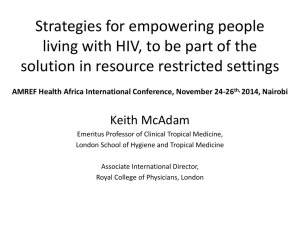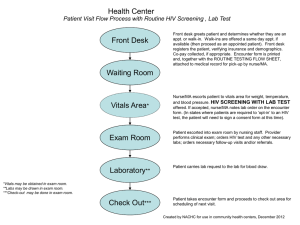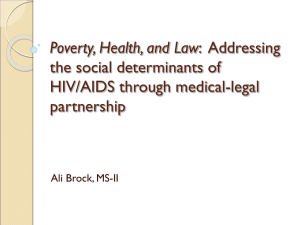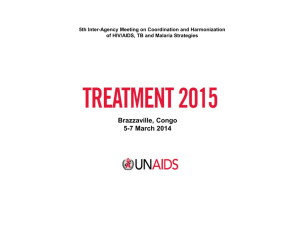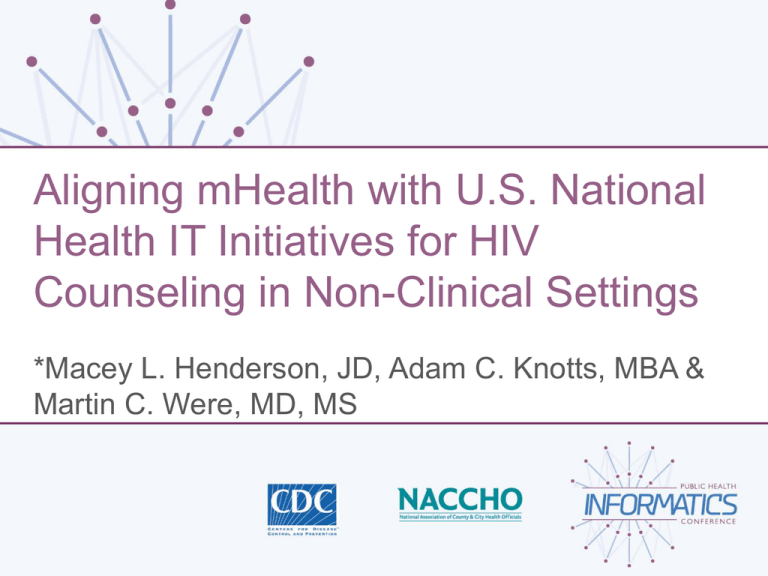
Aligning mHealth with U.S. National
Health IT Initiatives for HIV
Counseling in Non-Clinical Settings
*Macey L. Henderson, JD, Adam C. Knotts, MBA &
Martin C. Were, MD, MS
Acknowledgements
Academic & Research Advisors
Shaun Grannis, MD, MS
Malaz Boustani, MD, MPH
Dennis Watson, PhD
Paul Halverson, DrPh
Mobilify Technology
Michael Dowden, MBA
Andrew Roden, BS
Kigho Emenike, MPH
Marc Lane, JD, MBA
Tarik Rabie, MPH
Research Assistants
Braden Paschall
Kate Creager
Kaila Dunnick
Tyler Bowles
LaQuita Sparks
Christopher Huff
Christian Zimmerman
Learning Objectives
•
Learning Objective 1: Describe emerging role of mHealth in HIV
counseling, testing, and referral (CTR) within non-clinical setting, as a
demonstration of broad use of mobile technologies for public health
across multiple conditions.
•
Learning Objective 2: Explore national health IT standards and their
application for mHealth CTR tools that serve public health needs.
•
Learning Objective 3: Discuss the implications of FDA’s final guidance
on mobile applications, and current certification guidelines for health
information technologies on mHealth applications for public health,
using mHealth applications for HIV CTR as a reference use-case.
Commonly Used Acronyms
mHealth
IT
HIV
CTR
FTC
FDA
NIST
PHIN
RHIE
mobile health technology (for healthcare or public health)
information technology
human immunodeficiency virus
counseling, testing, and referral
Federal Trade Commission
Federal Food and Drug Administration
National Institute of Standards and Technology
Public Health Information Network
Regional Health Information Exchange
MOBILE APPS FOR
IMPROVED HIV CTR IMPACT
(photo credit: ROBYN BECK/AFP/Getty Images)
mHealth
• The use of mobile information and health IT for
improving population health outcomes:
- health promotion
- illness prevention
- health care delivery
- information systems
- workforce and training
• Has the potential to shift the paradigm on when,
where, how, and by whom health services are
provided and accessed
mHealth and HIV
•
HIV prevention, care, and treatment
•
mHealth tools support HIV priorities
including linkage to care, retention in
care, and adherence to ART
treatment
•
Short messaging services (SMS)
can be used for appointment and
medication reminders
•
Offers an opportunity to expand
health care services in areas with
limited resources
mHealth and HIV
• Mobile phones have the
potential to induce a paradigm
shift in resource-limited settings
by encouraging patients to stay
connected to health care
providers
• Will improve low-cost, highly
engaging, and ubiquitous
STD/HIV prevention and
treatment support interventions
“Just in one of our programs, we
did 1200 tests last year. That’s
1200 pieces of paper that have to
be entered into the system.
Instead of doing that, if we were
doing it on an iPad or whatever,
and that went into the system,
think of the steps we could save….
So those hours and dollars could
be spent doing more testing or
more outreach, saving the agency
money, you know, going into
something else.”
Enhanced Possibilities With a Mobile
Data Collection System in Nontraditional Settings
• Improved surveillance and
reporting
• Improved reach and public
health impact
Test Positivity Rates by setting (CDC, 2012)
Traditional
Non-Traditional
(Community Based
0.47%
0.82%
Dimensions of mHealth Technologies focused on HIV CTR
DEVELOPMENT
CONSIDERATIONS
FDA Regulations of Mobile Apps
•
MAY meet the definition of medical
device but for which FDA intends to
exercise enforcement discretion.
•
May be intended for use in the diagnosis
of disease or other conditions, or in the
cure, mitigation, treatment, or prevention
of disease.
•
Even though these mobile apps MAY
meet the definition of medical device,
FDA intends to exercise enforcement
discretion for these mobile apps
because they pose lower risk to the
public.
Mobile apps that use patient
characteristics such as age, sex, and
behavioral risk factors to provide patientspecific screening, counseling and
preventive recommendations from wellknown and established authorities
[Appendix B].
Mobile apps that enable, during an
encounter, a health care provider to
access their patient’s personal health
record (health information) that is either
hosted on a web-based or other platform
[Added March 12, 2014].
National Health IT Standards
• Common standards and implementation specifications
recommended for electronic data exchange within
meaningful use guidelines
• The concept of meaningful use rested on the '5 pillars' of
health outcomes policy priorities, namely:
– Improving quality, safety, efficiency, and reducing health
disparities
– Engage patients and families in their health
– Improve care coordination
– Improve population and public health
– Ensure adequate privacy and security protection for personal
health information
Infrastructure and Workforce
eHealth Exchange
• National
HIE
• Community/Regional
EHR
• Local
• National initiative to increase the capacity of public health
agencies to electronically exchange data and information
across organizations and jurisdictions
• Promotes the use of standards
• Defines functional and technical requirements for public
health information exchange
www.healthit.gov
SUPPORTING EVIDENCE FOR
DEVELOPMENT OF NEW MOBILE
DATA COLLECTION SYSTEM
King et al. (2013) King, J. D., Buolamwini, J., Cromwell, E. A., Panfel, A., Teferi, T.,
Zerihun, M., & Emerson, P. M. (2013). A novel electronic data collection system for
large-scale surveys of neglected tropical diseases. PloS one, 8(9), e74570.
• Studied the collection of data using mobile technology.
• Results:
• Gained 265 person-days using mobile technology as seen in Table 1.1
• Able to collect more data in less time
• 12% decrease in data entry error pertaining to blank field in census
record (age, sex, availability)
• Cost of equipment was similar between both methods, though continual
use of mobile equipment suggested increased savings overtime
• Gave instant results and obviated the need for double-data entry and
cross-correcting, thus reducing errors
“Electronic data collection using an Android-based technology was suitable for a large-scale
health survey, saved time, provided more accurate geo-coordinates, and was preferred by
recorders over standard paper-based questionnaires”.
Onono, M. A., Carraher, N., Cohen, R. C., Bukusi, E. A., & Turan, J. M. (2011). Use
of personal digital assistants for data collection in a multi-site AIDS stigma study in
rural south Nyanza, Kenya. African health sciences, 11(3).
• Describes the development, cost effectiveness, and implementation in
a PDA Based electronic system to collect, verify, and manage data
from a multi-site study on HIV/AIDS.
• PDA programmed for collecting and screening eligibility study data and
responses to structured interviews on HIV/AIDS stigma.
Successes included:
1. Capacity building of interviewers (workforce development)
2. Low cost of implementation
3. Quick turnaround time of data entry with high reliability
4. Convenience
Advantages of Paper to Mobile Transition
Double data entry
• 265 person-days
were gained
• Final data set
available one
month sooner
Accuracy
• Electronic: 1.8%
error rate
(n=38,652)
• Paper: 2.3% error
rate (n=33,800)
King et al. (2013)
Cost & Security
Study Example
Onono 2011
King 2013
Paper Based
$10,313
$13,883
Electronic Based
$6,471
$10,320
Savings
$3,842
$3,563
One device was stolen
“The stolen PDA was not recovered, but because data on the SD card
were encrypted and the PDA password protected, participant privacy
(Onono, et. al., 2011)
was not compromised.”
“It has to be compatible with our
reporting system….If it’s just
another exercise in collecting data,
it doesn’t do us any good. It has to
be compatible.”
Designed from a Use-Case Analysis
A NEW PROPOSED PROCESS
Current
Process
Community Health
Worker (CHW)
Collects Client’s
Information on pen
and paper.
CHW reenters
info into 3rd
party webbased portal
3rd party
manages
data
Bi-annual
hard upload
to CDC
Proposed
Process
CHW collects
info via Mobile
Tablet
Encrypted
data
transmitted to
3rd party data
management
company
Data sent to CDC
Current
Process
Community Health
Worker (CHW)
Collects Client’s
Information on pen
and paper.
CHW reenters
info into 3rd
party webbased portal
Security
3rd party
manages
data
Bi-annual
hard upload
to CDC
Cost
Double data entry
Data Accuracy
Proposed
Process
CHW collects
info via Mobile
Tablet
NIST Compliant
Diminishing Resources Over Time
Encrypted
data
transmitted to
3rd party data
management
company
Saved man power
Data validity increases
Data sent to CDC
Lower cost
Comparison
• 3rd party web-based portal cost to
CDC and community
organizations
• Security concerns
– No audit trail for paper, unable
to identify data breach
– Paper process not secure –
increased risk to HIPAA
violations
• Double data entry
– Strain on already resourceconstrained organizations
“I see less likelihood of HIPAA
violations with electronic
forms, because with the paper
forms, currently, they take it
back and input it and it might
not be the same person taking
it back and putting it in. So you
have multiple people touching
the forms.”
Implementation Study Overview
• Aim 1: Develop mobile data collection system
• Aim 2: Pilot test (mixed-methods)
• Aim 3: Develop an implementation strategy for
scalability
Aim 1: Develop Mobile Data
Collection System
1) Design basic system components
2) Develop protocols and procedures
Methods:
– Literature reviews
– Observations
– Key informant interviews
3) Alpha Test user-interface
Aim 2: Pilot Testing: Deployment
to Community Based
Organizations
1) Determine appropriate baseline data
– Recommendation: 1 month field observations, or analysis of
2) Beta Test (small sample size (n=10)
– collect quantitative and qualitative data
Technical and workforce components
3) Develop a logic model to describe the
process and to inform implementation
strategy
Aim 3:Develop an Implementation
Strategy for Scalability
1) When developing the implementation
strategy, fidelity will be a key issue
2) Developing a fidelity tool
Could be a checklist, or a scale?
References
Muessig, K. E., Pike, E. C., LeGrand, S., & Hightow-Weidman, L. B. (2013). Mobile phone applications for the care and prevention of HIV and other sexually
transmitted diseases: a
review. Journal of medical Internet research, 15(1).
Heslop, L., Weeding, S., Dawson, L., Fisher, J., & Howard, A. (2010). Implementation issues for mobile-wireless infrastructure and mobile health care computing
devices for a
hospital ward setting. Journal of medical systems, 34, 509-518.
Veniegas, R. C., Kao, U. H., & Rosales, R. (2009). Adapting HIV prevention evidence-based interventions in practice settings: an interview study. Implementation
Science 4(1), 76.
Maiorana, A., Steward, W. T., Koester, K. A., Pearson, C., Shade, S. B., Chakravarty, D., & Myers, J. (2012). Trust, confidentiality, and the acceptability of sharing
HIV-related patient data: lessons learned from a mixed methods study about Health Information Exchanges. Implementation Science, 7(1), 34.
Littman-Quinn, R., Mibenge, C., Antwi, C., Chandra, A., & Kovarik, C. L. (2013). Implementation of m-health applications in Botswana: telemedicine and education
on mobile devices in a low resource setting. Journal of telemedicine and telecare, 19(2), 120-125.
Leon, N., Lewin, S., & Mathews, C. (2013). Implementing a provider-initiated testing and counselling (PITC) intervention in Cape town, South Africa: a process
evaluation using the normalisation process model. Implementation Science, 8(1), 97.
Lester, R. T., Mills, E. J., Kariri, A., Ritvo, P., Chung, M., Jack, W., & Plummer, F. A. (2009). The HAART cell phone adherence trial (WelTel Kenya1): a
randomized
controlled trial protocol. Trials, 10(1), 87.
Lester, R. T. (2013). Ask, Don't Tell—Mobile Phones to Improve HIV Care. New England Journal of Medicine, 369(19), 1867-1868.
Furberg, R. D., Uhrig, J. D., Bann, C. M., Lewis, M. A., Harris, J. L., Williams, P., & Kuhns, L. (2012). Technical Implementation of a Multi-Component, Text
Message–Based Intervention for Persons Living with HIV. JMIR Research Protocols, 1(2).
Hardy, H., Kumar, V., Doros, G., Farmer, E., Drainoni, M. L., Rybin, D., & Skolnik, P. R. (2011). Randomized controlled trial of a personalized cellular phone
reminder system to enhance adherence to antiretroviral therapy. AIDS patient care and STDs, 25(3), 153-161.
Lester, R. T., Ritvo, P., Mills, E. J., Kariri, A., Karanja, S., Chung, M. H., ... & Plummer, F. A. (2010). Effects of a mobile phone short message service on
antiretroviral treatment adherence in Kenya (WelTel Kenya1): a randomised trial. The Lancet, 376(9755), 1838-1845.
CDC. (2010). Vital Signs: HIV Testing in the U.S. , from http://www.cdc.gov/nchhstp/newsroom/docs/Vital-Signs-Fact-Sheet.pdf
CDC. (2011). Estimates of New HIV Infections in the United States, 2006-2009, from http://www.cdc.gov/nchhstp/newsroom/docs/HIV-Infections-2006-2009.pdf
CDC. (2012). Healthy People 2020 Leading Health Indicators: Objective HIV-13: Proportion of Persons Living with HIV Who Know Their Serostatus.
CDC. (2013). Assessment of 2010 CDC-funded Health Department HIV Testing Spending and Outcomes.
Seffah, A., Donyaee, M., Kline, R. B., & Padda, H. K. (2006). Usability measurement and metrics: A consolidated model. Software Quality Journal, 14(2), 159-178.


